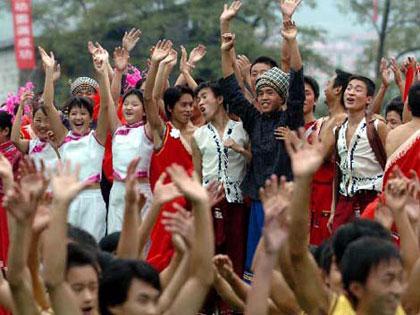The Tujia Hand-Swinging Dance
2009-08-11 09:43 BJT
Originated from the primitive sacrificial dance, the Tujia hand-swinging dance of western Hu'nan is a folk dance most characteristic of the Tujia nationality and best representative of the age-old Tujia traditions. The dance is mainly popular in areas like Longshan, Baojing and Youngshun etc of western Hu'nan. Stemming from the old ancestor-worshipping rituals of the Tujia nationality, the hand-swinging dance has been around for nearly a thousand years according to the extrapolation from the remnant inscriptions on the stone tablets in the Ba Bu Da Wang temple of the Qing Dynasty and from county annals.
 |
| Tujia hand-swinging dance of western Hu'nan is a folk dance most characteristic of the Tujia nationality and best representative of the age-old Tujia traditions. |
The Tujia hand-swinging dance of western Hu'nan is a combination of singing, dancing, music playing and drama performance. The dance movements are mostly the reenactment of the Tujia people's life, work and even wars. The movements are bold, robust and rhythmic. After worshipping their ancestors by presenting offerings like ox heads, pig heads, cakes, rice wine and bacon, the Tujia people begin to dance from dusk to dawn. In some case, they dance for several nights on end. There's another hand-swinging dance that's performed on a grand scale in the open air. It is a magnificent war dance with great vitality.
In most cases, the hand-swinging dancer performs by swinging the right hand and stepping the right foot; and swinging the left hand and stepping the left foot. This is what's known as the right order. The crooking of the knees is a noticeable feature of the dance. The knees are usually bent during the whole dancing process, especially at the last beat of each movement, when the knees are bent even more crooked.
The songs going with the hand-swinging dance are called "hand-swinging songs", which are a kind of age-old folk dance music of the Tujia nationality. The hand-swinging songs are all sung in the Tujia language in various forms like chorus, chorus with a leading singer and solo. The songs cover a wide range of subjects, including history, military affairs, production, and love etc. The hand-swinging dance is mainly accompanied by big gongs and big drums that produce simple and sprightly rhythms. Sometimes, bass horns and suona horns are also used. The dancer changes his or her movements as the drummer strikes the edge of the drum.
The costumes for the hand-swinging dance are quite unique. Most are made of home-spun cloth, usually blue, black and red. Male dancers wrap their head with a band of black or white cloth, wearing a loose, short, collarless, and front opening jacket with broad sleeves, with a small bag tied to the belt. Female dancers wear a broad-sleeved loose jacket and loose pants. The cuffs and bottoms of trouser legs are bordered with a five-Chinese inch-wide edge, with a 7-Chinese inch–wide velvet edge inside. The shoes of both men and women are joined by two pieces. Men's shoes are mostly black, with thick soles. Women's shoes have low-cut uppers and slightly upturned tips and are embroidered on both sides. The seams of the heels are open, woven with flaxen threads.
During the Spring Festival every year, the Tujia people, draping floral quilt covers of various colors over their shoulders and holding lanterns, torches and multicolored brocade flags, flood to the "hand-swinging hall" right after supper. They also bring along the old and the young to the venue. There, they would fire blunderbuss shots and then dance the hand-swinging dance around big trees to the accompaniment of drums and gongs.
Editor: Zhang Wen | Source: Cultural China
 Mail
Mail Share
Share Print
Print


 Video
Video









 2009 China Central Television. All Rights Reserved
2009 China Central Television. All Rights Reserved